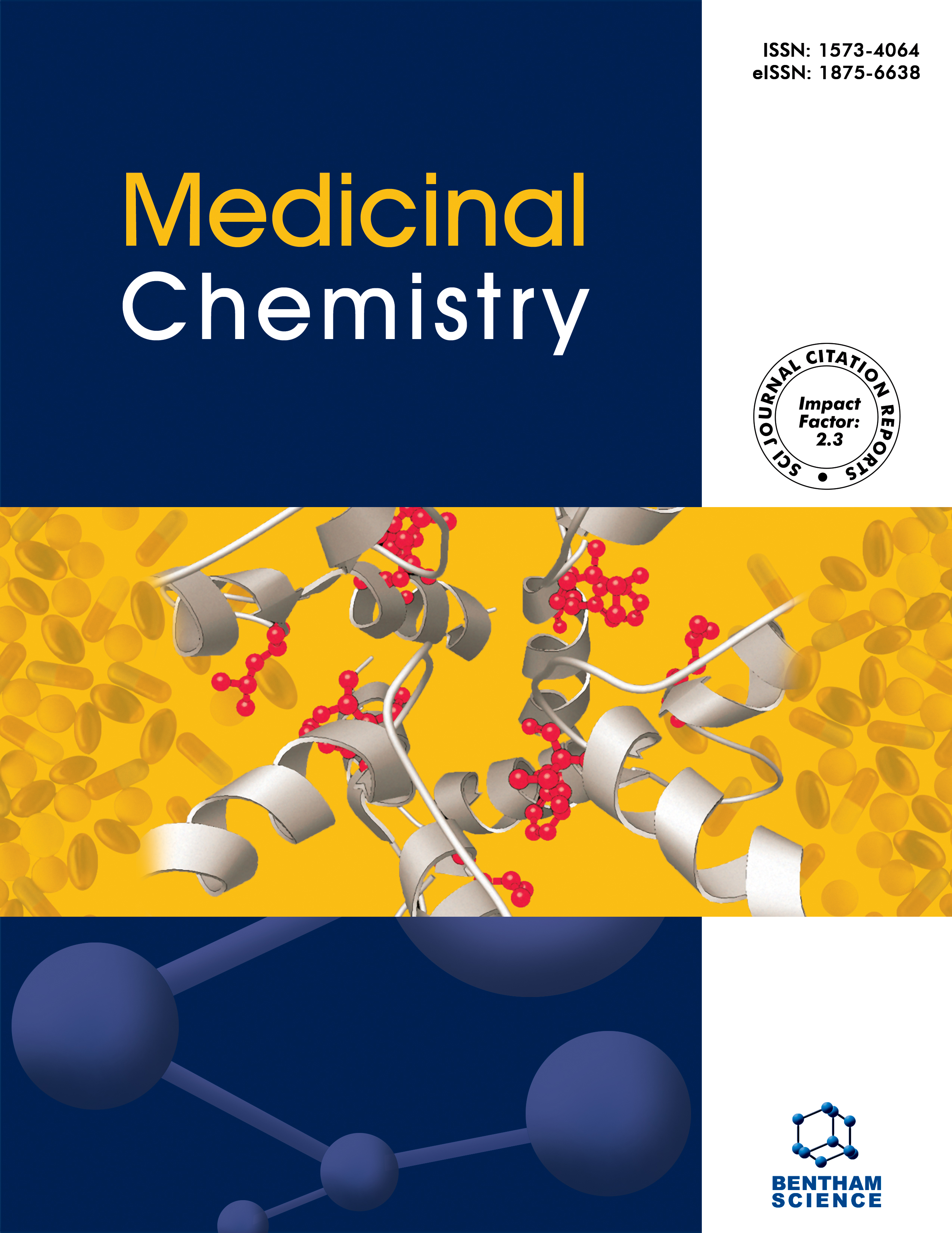- Home
- A-Z Publications
- Medicinal Chemistry
- Previous Issues
- Volume 10, Issue 2, 2014
Medicinal Chemistry - Volume 10, Issue 2, 2014
Volume 10, Issue 2, 2014
-
-
Defense Mechanisms of the Respiratory System and Aerosol Production Systems
More LessAerosolized therapies have been used in everyday clinical practice for decades. Experimentation with different delivery systems have led to the creation of aerosolized insulin, antibiotics, gene therapy and chemotherapy. Several of these therapies are already clinically available while others are being investigated in active clinical trials. The main factors affecting the efficiency and safety of the aerosolized therapies are the pr Read More
-
-
-
Androstenediol Modulates Sepsis Induced Alterations of Survival and Immune Functions in a Murin Model of Sepsis
More LessAuthors: Daniel Schmitz, Sven Lendemans and Reiner OberbeckBackground: Recently the benefit of subcutaneously applied dehydroepiandrosterone (DHEA) during sepsis was demonstrated. It was therefore supposed that the impact of DHEA might be induced by its metabolite androstenediol produced via conversion in subcutaneous tissue. Thus we postulate a comparable impact of intravenously applied androstenediol like DHEA. Material and Methods: Male NMRI mice were subjecte Read More
-
-
-
Studies on Novel Pyridine and 2-pyridone Derivatives of N-arylpiperazine as α-adrenoceptor Ligands
More LessThis paper describes the synthesis of a series of new N-arylpiperazine derivatives of pyridine and 2-pyridone. The in vitro pharmacological study indicated that all of the compounds possess affinity towards α1-adrenoceptors, with exception of 6d, and are selective over α2 receptor. The most potent compound 5f displayed 62-fold α2/α1 selectivity with Ki value of 27.3 nM for α1 receptor. Selectivity of other ligands ranged from Read More
-
-
-
Pharmacological Properties of Novel Cyclic Pentapeptides with μ-opioid Receptor Agonist Activity
More LessIn our previous paper we have reported the synthesis and biological activity of a cyclic analog, Tyr-c(D-Lys- Phe-Phe-Asp)-NH2, based on endomorphin-2 (EM-2) structure. This analog displayed high affinity for the '-opioid receptor, was much more stable than EM-2 in rat brain homogenate and showed remarkable antinociceptive activity after intracerebroventricular (i.c.v.) injection. Even more importantly, the c Read More
-
-
-
2D QSAR Studies on Series of Human Beta-secretase (BACE-1) Inhibitors
More LessAuthors: Daniela Santos Cruz and Marcelo Santos Castilhoβ-secretase (BACE-1) plays a pivotal role in the β-Amyloid plaques formation, which is responsible for progressive cognitive and memory loss commonly found in Alzheimer disease patients. As a consequence, it has been considered as a good target for drug development efforts. Early work focused on the synthesis of peptidomimetics, but poor pharmacokinetics profile prevented advancing lead compounds to clinical tr Read More
-
-
-
A Quantitative Structure-Activity Relationship Study on a Series of Selective Non-zinc Binding Inhibitors of MMP13
More LessTwo novel series of potent and selective matrix metalloproteinase (MMP) inhibitors, involving unique binding mode at the active site and not interacting with the catalytic zinc, were collectively investigated to quantify their inhibition actions in relation with chemometric descriptors. Significant correlations, between their MMP13 inhibition activity and 2D-descriptors, were obtained through the combinatorial protocol in Read More
-
-
-
Syntheses and Antimycobacterial Activities of [(2S,3R)-2-(Amino)-4- (Arenesulfonamido)-3-Hydroxy-1-Phenylbutane Derivatives
More LessThe syntheses of hydroxyethylsulfonamides, (2S,3R)-tert-butyl N-[4-(N-benzyl-4-R-phenylsulfonamido)-3- hydroxy-1-phenylbutan-2-yl]carbamates and (5) (2S,3R)-2-amino-4-[N-benzyl-4-R-benzenesulfonamido]-3-hydroxy-1- phenylbutane hydrochlorides (6), derived from (2S,3S)-Boc-phenylalanine epoxide, are reported. None of the compounds, containing the Boc group, showed activity against M. tuberculosis ATTC 2 Read More
-
-
-
Chemometric Studies on Potential Larvicidal Compounds Against Aedes Aegypti
More LessThe mosquito Aedes aegypti (Diptera, Culicidae) is the vector of yellow and dengue fever. In this study, chemometric tools, such as, Principal Component Analysis (PCA), Consensus PCA (CPCA), and Partial Least Squares Regression (PLS), were applied to a set of fifty five active compounds against Ae. aegypti larvae, which includes terpenes, cyclic alcohols, phenolic compounds, and their synthetic derivatives. The calculation Read More
-
-
-
Antimosquito Properties of 2-Substituted Phenyl/benzylamino-6-(4- chlorophenyl)-5-methoxycarbonyl-4-methyl-3,6-dihydropyrimidin-1-ium Chlorides Against Anopheles arabiensis
More LessEight novel dihydropyrimidine analogs named DHPM1-DHPM8 was synthesized in their hydrochloride salt form using one pot synthesis between methyl 2-chloro-4-(4-chlorophenyl)-6-methyl-1,4-dihydropyrimidine-5-carboxylate and substituted arylamines in isopropanol. The antimosquito effect of the test compounds were assessed against the adult mosquito Anopheles arabiensis. For adulticidal properties the test compou Read More
-
-
-
Synthesis, Antibacterial, Antifungal and Antitubercular Activities of N-Pyrazolylbenzamide Derivatives
More LessA series of new N-pyrazolylbenzamides (5a–x) were synthesized by aroylation of 5-amino-1-phenyl-3-tbutylpyrazole. The structures of synthesized compounds were established based on spectral (FTIR, 1H NMR, ESI Mass) analysis and purity was ascertained by HPLC. The antibacterial screening revealed that seven molecules exhibited an excellent antibacterial activity and eight compounds demonstrated considerable antifungal Read More
-
-
-
An Expedient Synthesis and Screening for Antiacetylcholinesterase Activity of Piperidine Embedded Novel Pentacyclic Cage Compounds
More LessThe aim of this study was to synthesize and evaluate diazapentacyclic analogs for their acetylcholinesterase (AChE) inhibitory activity. The pentacyclic analogs were synthesized by one-pot three-component domino reactions in a microwave synthesizer. Most of the compounds exhibited moderate to good AChE inhibitory activity, compound 5i showed potent inhibitory activity with IC50 1.12±0.01 μM and this may provide Read More
-
Volumes & issues
-
Volume 21 (2025)
-
Volume 20 (2024)
-
Volume 19 (2023)
-
Volume 18 (2022)
-
Volume 17 (2021)
-
Volume 16 (2020)
-
Volume 15 (2019)
-
Volume 14 (2018)
-
Volume 13 (2017)
-
Volume 12 (2016)
-
Volume 11 (2015)
-
Volume 10 (2014)
-
Volume 9 (2013)
-
Volume 8 (2012)
-
Volume 7 (2011)
-
Volume 6 (2010)
-
Volume 5 (2009)
-
Volume 4 (2008)
-
Volume 3 (2007)
-
Volume 2 (2006)
-
Volume 1 (2005)
Most Read This Month
Article
content/journals/mc
Journal
10
5
false
en


